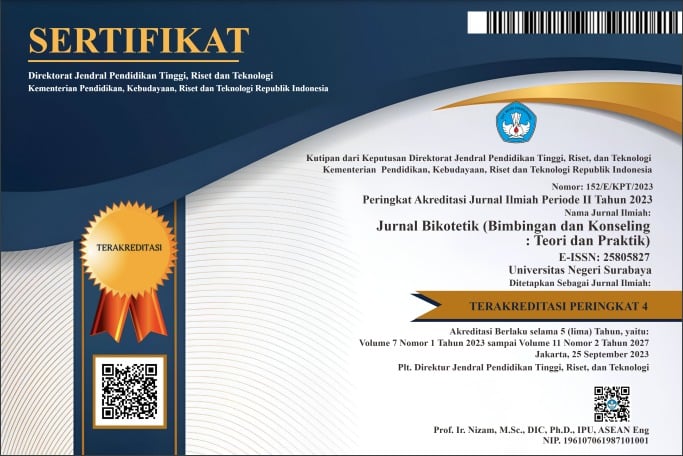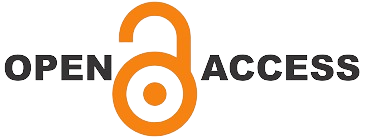PENGEMBANGAN MODUL CULTURAL AWARENESS UNTUK KONSELOR SEBAYA
DOI:
https://doi.org/10.26740/bikotetik.v1n1.p30-36Keywords:
Modul Cultural awareness, Konselor SebayaAbstract
The process of attaining adolescent self-identity is strongly influenced by environmental conditions in which group culture greatly influences its success. Therefore students need to have a mantab cultural awareness to minimize the negative influence of the surrounding culture. Cultural awareness is a competence that naturally exists in the individual and develops according to the pattern of individual development, meaning individual cultural awareness can be developed.
Limitations on the number of school counselors lead to many unresolved issues. Peer guidance program (peer counselor) is one solution to help students. Given the importance of the position of peer counselor then it is necessary that the media develop the competence of multicultural counselors in self counselor peer. One of the competencies developed is the competence of cultural awareness. Cultural awareness competencies help peer counselors to integrate their surrounding culture with their own culture, meaning that this competency is a capability that helps peer counselors take a proactive stance toward cultural differences, recognize and value each individual's multiculturality.
The importance of developing multicultural counselor competencies in peer counselors has not been matched by the development of the media. Therefore, it takes a medium that can be used as a guide for peer counselors in developing their cultural awareness competence. The media is a cultural awareness module for peer counselors. Development This module is limited to acceptability stages that meet the four aspects of standard usability, convenience, accuracy and propriety. With the module developed, it is expected to maximize the implementation of peer guidance in school.
Validation tests are performed by media validators, material validators and users. The revision of phase 1 is done after material validation and revision phase 2 after media validation. Material validation is done by counseling expert with minimum education qualification of S2 and teaching cross-cultural counseling course, media validation is done by expert in media with minimum qualification S2. User validation is performed by peer counselors at SMAN 11 Surabaya.
From the expert validation result get the percentage value 85,93% from media validator, 87,5% from material validator and 82,5% from user validator for usability aspect, feasibility, accuracy, and propriety. The averages when adjusted to the assessment criteria according to Mustaji (2005: 102) turned out to fall into very good category (81% -100%). So it can be stated that this cultural awareness module meets the criteria of acceptability with very good predicate, no need to be revised.
References
Hartinah, Siti. 2009. Konsep Dasar Bimbingan Kelompok. Bandung: Refika Aditama.
Kertamuda, Fatchiah. 2011. Konselor dan Kesadaran Budaya (Cultural Awerness). https://bkpemula.files.wordpress.com/2011/12/07. Diakses 20 Maret 2016.
Lee, W.M.L, Blando, J.A, Mizelle, N.D, Orosco, G.L. 2007. Introduction to Multicultural Counseling for Helping Professional (2nd ed). New York: Taylor & Francis Group.
Mustaji dan Sugiarso. 2005. Pembelajaran Berbasis Konstruktivistik. Surabaya: UNESA University Press.
National Center for Cultural Competence. http://nccccurricula.info/awareness/index.html. Diakses tanggal 20 Maret 2016.
Papalia, D E., Olds, S. W., & Feldman, Ruth D. 2001. Human development (8th ed.). Boston: McGraw-Hill.
Pusdikalat KB & KB PPMPKB. 2008. Pelatihan Pembimbing Sebaya. Jakarta: materi tidak diterbitkan.
Quappe, Stephanie and Giovanna Cantatore. 2005. What is Cultural Awareness, anyway? How do I build it?. http://www.culturosity.com . Diakses 25 Maret 2016.
Republika.co.id. KPAI: Jumlah kasus bulliying di Jakarta meningkat. Diakses 8 Maret 2016.
Santrok, J.W. Life Span Development-Perkembangan Masa Hidup.2002. Jakarta: Erlangga
Seputar Indonesia. Program Pemerintah Surabaya œPelajar Penggerak Perubahan. Tayang 5 Maret 2015.
Sugiyono. 2013. Metode Penelitian Pendidikan: Pendekatan Kuantitatif, Kualitatif, dan R&D. Bandung: Penerbit Alfabeta.
The Joint Committee on Standards for Educational Evaluation. 1981. Standards for Evaluations of Educational Programs, Projects, and Materials. USA: McGraw-Hill Book Company.
Tim Puslitjaknov. 2008. Metode Penelitian Pengembangan. Pusat Penelitian Kebijakan dan Inovasi Pendidikan: Badan Penelitian dan Pengembangan Departemen Pendidikan Nasional
Van, Kan. Peer Counseling Tool and Trade a Work Document. 1996. www.peer_counseling.org
Wunderle, William. 2006. Through the Lens of Cultural Awareness: A Primer for US Armed Forces Deploying to Arab and Middle Eastern Countries. USA: Combat Studies Institute Press.
Www.Indonesia-investment.com. Diakses tanggal 28 Juli 2015.
www.surya.co.id. Ada Bulliying di SMAN 18 Surabaya, Siswa Baru Mogok Orientasi. Diakses 8 maret 2016
Yusuf, Syamsu. 2007. Psikologi Perkembangan Anak & Remaja. Bandung: Remaja Rosdakarya.
Wijaya, C. 1992. Upaya Pembaharuan dalam Pendidikan dan Pengajaran. Bandung: Remaja Rosda Karya,
Downloads
Published
How to Cite
Issue
Section
 Abstract views: 1981
,
Abstract views: 1981
, PDF Downloads: 1973
PDF Downloads: 1973









